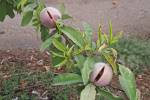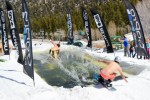Winter water schedule relies on temperatures
Q: We moved into a new house this summer and planted a flowerbed around the front. The yard was planted in grass seed. Because of the dry conditions, we couldn't keep up with the lawn watering and a large area of the yard was recently replanted with seed. I'd like to know when should I stop watering for the winter?
A: The answer is to not stop watering until the ground freezes. If this winter turns into another La Niña winter of warm and dry weather, you may even need to do more watering later during the winter. If your area doesn't freeze at all, or for a very short time, you may need to keep watering all winter. In future years, you won't have to do this.
Trees, shrubs and perennials will not have as large of a root system this year as they will in future years; therefore, they do not have as much area in the ground to draw water from. The grass seedlings will not develop less of a crown and may not have many roots, depending on when they were planted. They may not be able to store enough moisture to last the entire winter.
If there is a lot of snow cover, most plants will be fine. But long periods of time with no snow and strong wind may cause new plants and some lawn areas to dry out and die. Even though the grass, shrubs and other plants are dormant, and may not have leaves, roots, crowns, stems and trunks, they still need some moisture to survive. Evergreens are much more sensitive to drying out in the winter because their leaves are exposed to the cold, dry winds.
The best time of day to water is still in the early morning hours. The plants can dry off soon after the watering, as the sun comes up; they are less likely to develop fungal diseases. Water just enough to get the soil wet, about 6 inches to 8 inches deep. This will get to the majority of the roots in most grasses, shrubs and newly planted material. In the summer, an occasional deeper watering is good for some trees that have roots down to 18 inches.
Put out a can or a rain gauge to see how long it takes to get about a half-inch of water from your sprinkler. Dig a test hole and see how far that water went. In most soils, a half-inch of rain will soak the soil about 6 inches. Set your sprinkler to run for that long, no longer. More water will just be wasted. In cool weather, once or twice a week should be fine for almost any plants. Small grass plants in new lawn areas as well as shrub bed areas next to a building or on a south-facing slope, where the temperature stays warmer and the soil may dry out faster, may need to be watered more often.
Once the ground freezes you can quit. If the winter weather does not give enough moisture, it will be beneficial to do more watering. When the ground is frozen, the watering will do no good, unless you also want to ice skate on your lawn. Many areas of the country get a January thaw that gives us a week of above-freezing temperatures. That would be a good time to get a little water to the grass and evergreens; however, most other plants won't need the watering. If your area doesn't freeze or even become very cold, you will have to keep watering through the winter to help the plants grow a full root system.
Do not leave water in the hose and let it freeze, or you will have a hard time rolling it up. You might also damage the hose spigot and get a leak in the house.
Your perennials and any that are planted in the fall need a 3-inch layer of mulch covering the roots and dormant crown. Shrubs and trees need to have the root area covered in mulch. This helps to even out the freezing and thawing cycles. Since the soil of the planting and the original soil are often different in texture and water content, they will freeze at a different rate. This can lead to the plant being pushed up out of the ground, where it will dry out and die. After the plant has established roots into the surrounding soil, the frost action will not happen anymore.























